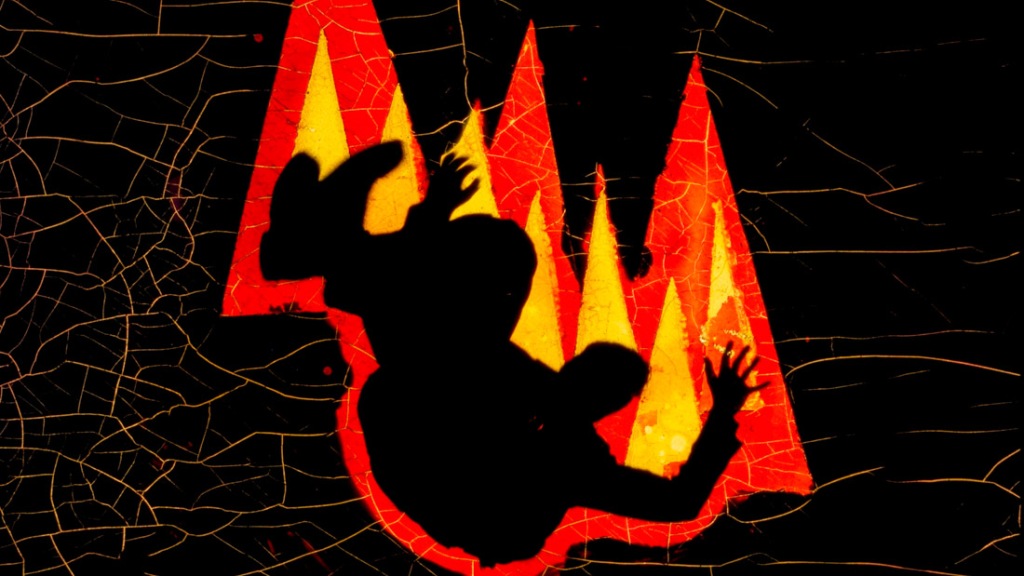
November (Rehepapp) is a black-and-white film that draws upon Estonian history and folklore. It plays out like a timeless, definitely-not-Disney fairy tale – almost everybody is dressed in rags and has a very dirty face, even though they DO have saunas. As far as we can see, those saunas are used more by the dead than by the living. Every autumn, villagers await their deceased relatives in the local graveyard, then take them home for food, gossip and a sauna. Rumour has it that the dead are somehow transformed into giant chickens while using the sauna.
Even more fantastical than those ideas, for me, was the concept of the kratt – a sometimes cranky, sarcastic creature made from odds and ends (branches, pitchforks, hay) who serves his master by stealing things and doing chores around the farm. A kratt does not come cheaply, though – a person has to sell his soul to the devil to make his kratt come alive. Where does one meet the devil? At the crossroads, in the dead of night, of course.
There’s nothing bucolic about life in the countryside – the peasants face hunger, poverty and the plague. There is conflict between parent and child, Christianity and paganism. Co-operation seems like an unknown concept; greed and selfishness abound. People are willing to betray family, friends, and neighbours for any small advantage. Many hope to get their hands on a legendary cache of hidden silver.

Young Liina (Rea Lest) lives with her father, who wants to marry her off to his gross old drinking buddy, Endel. Liina will have none of it; she wants to marry Hans (Jörgen Liik), her friend and contemporary. But Hans is smitten by the sleep-walking daughter of the German baron who rules the area from his imposing manor house. (Unlike the others, the baron and his daughter have clean faces and clean clothes. At home, the baron wears a fancy embroidered coat that makes him look the Liberace of his day. German actor Dieter Laser plays the baron; Imdb.com says he was also in the Human Centipede films.)

Google tells me that Estonia was among the last European countries to be Christianized, and the last to abolish serfdom, as well. Though the characters in the film are nominally Christian, that doesn’t stop them from stealing things from the church, nor does it stop Liina from asking a witch to help her win Hans over. If they are still serfs, that would go far in explaining their miserable circumstances.
I saw November (Rehepapp) at the Fantasia International Film Festival in Montreal. Both screenings were sold out, so I was very lucky to see it at all. Unlike some of the other popular films at the festival, November is not full of laughs, or action, but it’s well worth seeking out.
Oscilloscope Films has the North American distribution rights and will give the film a theatrical release in the fall. Watch out for it! An article on the Deadline.com web site has a very apt quote from Oscilloscope’s Dan Berger: “November is one of the most unique and stunning films to come along in some time. It’s equal measures beautiful love story and balls-to-wall bonkers-ass folk tale. It keeps you rapt, guessing and intrigued from its first frame to its last.” Yeah, what he said!
Some films are quite entertaining while we’re watching, but once they’re over we move on. After watching November the first thing I looked up was the kratt – was it the author’s invention or was it part of folklore? Folklore it was! Then I wanted to know about Estonian history, its rulers, serfdom, paganism and Christianity, saunas for the dead, the ravages of the plague, etc., etc. I really like it when that happens, though such exploration delays my reviews a bit.
November’s cinematographer Mart Taniel won the Best Cinematography in an International Narrative Feature award at the 2017 Tribeca Film Festival. I can’t find photos of one of the more stunning images in the film – a lake surrounded by trees with white leaves.
November is based on the novel Rehepapp, by Andrus Kivirähk. There doesn’t seem to be an English translation yet, but it has been translated into French, as Les Groseilles de novembre: Chronique de quelques détraquements dans la contrée des kratts. Another book by Andrus Kivirähk has been translated into French as Homme qui savait la langue des serpents. In English it is called The Man Who Spoke Snakish. Kivirähk’s books are available at Amazon and Indigo; Indigo has German and Spanish translations of the “Snakish” book, as well.

November (Rehepapp) is an Estonia, Poland, Netherlands co-production, in Estonian and German, with English subtitles.
Written and directed by Rainer Sarnet
Cast: Rea Lest, Jörgen Liik, Dieter Laser, Katariina Unt, Taavi Eelmaa, Arvo Kukumägi, Heino Kalm, Meelis Rämmeld
Cinematographer: Mart Taniel
Production company: Homeless Bob Production, PRPL, Opus Film
North American distribution by Oscilloscope.






















